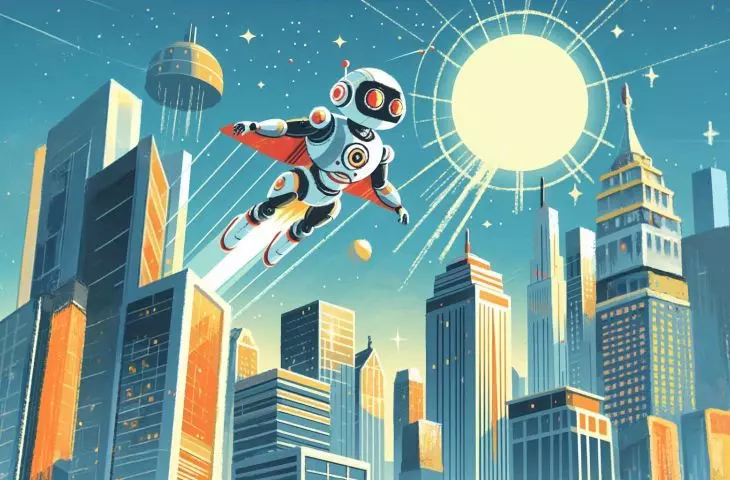What if I told you there was a flying robot outside your window? Or even better - in your apartment? Visions from sci-fi movies may now come to mind, but rest assured, what I'm writing about is much closer to life, ordinary everyday life, and provides a faster city. Already your phone is contributing to it, as is a whole network of sensors, transmitters and software.
The urban area is in a way a robot, a mechanized organism. The more technology in it, using various electronic methods and sensors to collect data, which is then analyzed to improve the management of the city's assets, resources and services, the further it is on the ladder of Smart City sophistication. The Polish equivalent of this concept is the Smart City. The very name doesn't sound good - quite as if the city has its own independence, reason and perhaps works against humans. This is not the most accurate term. The Englishsmart is something between "intelligent," "smart" and "agile" or "resourceful." The goal of the emergence of such a city model is to improve the quality of life of citizens while optimizing operational efficiency in various sectors, not technology per se. Of course, the integration of information and communications technology (ICT) and the Internet of Things (IoT) is central to the Smart City concept. This enables real-time data collection and analysis. All of this in effect is to effectively solve the problems of us, the users of the city. It is also possible to better manage resources, improve quality of life and increase the operational efficiency of the city.
evolution of the concept
The Smart City concept continues to evolve through successive generations, each of which has had a slightly different approach to the use of technology.
Smart City 1.0: Technology-driven cities
The first generation of cities was mainly driven by multinational technology corporations that provided advanced solutions to transform traditional cities into futuristic metropolises. During this phase, cities were often not fully aware of the real needs of their residents and introduced technological solutions from above, without consulting local communities. This approach often led to unsustainable development and inadequate, over-scaled investments with big operator logos.
Smart City 2.0: Local government-led, technology-supported cities
In the second generation, local authorities took the lead in analyzing their needs and finding appropriate technological solutions to solve local problems. Cities began to take advantage of residents' opinions and needs, adapting technology somewhat to improve their quality of life. This approach was more relevant, as technologies were selected and implemented according to needs, but these were mainly the needs of local government officials.
Smart City 3.0: Co-creation with citizen participation
The third generation is characterized by cooperation between local authorities, technology companies and citizens. In this model, citizens have a real impact on shaping their environment thanks to tools that allow them to actively participate in decision-making processes. This form of co-creation allows for a more individualized and effective approach to solving urban problems, leading to a better understanding and satisfaction of community needs.
These three concepts come up most often when we talk about Smart City. However, the further into the technological woods we get, the newer the editions, which have more up-to-date demands. And so we have already encountered Smart City 4.0, a concept referred to as Synergy-Driven. Reading about the fourth generation of the concept, it's easy to come across phrases such as "building a new quality of life by promoting synergy," "harnessing innovative potential" or "synergistic actions to achieve sustainable development." In reality, this means measures to improve access to municipal services and increase their impact on the future of cities. In an analysis of the impact of solutions on development, ESI ThoughtLab surveyed 167 cities from 82 countries with more than 526 million people, or 6.8% of the world's population. Based on this research, 20 fourth-generation cities were identified, including Aarhus, Los Angeles, Madrid, New York, Berlin, Paris, Philadelphia, Copenhagen, Tallinn, London and Vienna. These cities are advanced both in terms of their progress toward the UN Sustainable Development Goals and their effective implementation of digital technologies and data.
In addition to advanced technologies, soft capabilities are also growing in importance. From the perspective of the Smart City concept, it is crucial to build on these four pillars - the 4T potentials: Technology, Talent, Tolerance andTrust. The sophistication of these elements in the management of a city determines its intelligence, entrepreneurship and innovation. A high level of the 4Ts determines the quality of life of residents and the competitive position of the metropolis.
One step further is the fifth generation of the Smart City, which introduces an urban digital ecosystem where each element of a city can be represented by an agent acting on its behalf. If you are now faced with the agents from "The Matrix " - let me reassure you, they are absolutely not the ones in question here. An agent in Internet of Things (IoT) and Smart Cities technologies is an autonomous unit of software or hardware that acts on behalf of a user or other program to perform tasks and make decisions based on collected data and specified goals. Agents can operate independently or collaborate with other agents to form a network of interconnected and communicating devices and systems. This allows services to interact both vertically and horizontally in the proposed ecosystem, fostering competition and cooperation through network protocols that balance the conflicting interests of different urban actors.
Simplifying, we can say that Smart City 5.0 is a vision of cities that put people at the center, focusing on improving the quality of life and well-being of all citizens. Technology plays a key role here, serving to solve social problems and create inclusive, equitable urban environments. This model of urban governance aims to create a space where every resident feels involved and valued.
how is it being done?
In Seoul, South Korea, an mVoting platform has been implemented. It allows citizens to submit proposals for local policies and vote for them online. Since March 2017, Seoul residents have voted on more than 4,000 proposals, with as many as 88% coming directly from them. Barcelona, in turn, created the Decidim platform, which allows residents to participate in local decision-making and submit their own proposals. Such platforms activate citizens, allowing them to have a real impact on the future of their cities through active participation in local policy-making.
The integrated approach to urban systems is another example of implementation. Copenhagen has launched the Copenhagen Street Lab project, which supports developers in testing and integrating Smart City solutions into existing city infrastructure. This allows the city to get a complete picture of how its systems are functioning and better optimize them. The key here is to integrate modern technologies with legacy systems to ensure efficient city management and service delivery.
Another interesting approach is to use existing infrastructure in new ways. London, UK, has decided to transform its landmark streetlights into Smart City elements. They have been equipped with sensors, air monitors and electric vehicle charging points. As of 2018, more than 8,000 charging points have been installed there, thus contributing significantly to the progress of the mobility transformation. This kind of technology deployment saves resources and avoids costly construction work, while bringing non-invasive modern solutions to public spaces.
Currently, the largest investments are being made in cloud (87% of cities), mobile (85%), IoT (81%), biometrics (72%) and AI (66%). Digital twins (+164%), 3D printing (+125%) and augmented reality/virtual reality (+63%), as well as data warehousing (+50%) are also forecast to be the technologies generating the most investment growth over the next three years.
future generations also smart
Smart City is not only a technology, but also a philosophy. No city is perfect, including in the category of technology implementation. That is why new generations are emerging and will continue to emerge. Smart Cities will continue to evolve, probably toward greater sustainability, using renewable energy sources, green infrastructure and closed-loop economy principles. A key aspect will also be the resilience of cities, which will need to adapt to climate change, natural disasters and other challenges by building robust systems and preparing for emergencies. As technologies such as artificial intelligence, the Internet of Things and autonomous vehicles become increasingly integrated into urban infrastructure and services, cities will need to redefine their approach to governance and urban planning.














